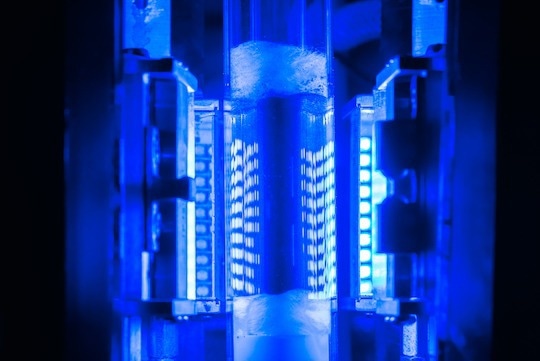Governments and corporations are under increasing pressure to adopt large-scale renewable energy sources and meet current climate goals to help mitigate the effects of the climate crisis.

Image Credit: Rice University
With wind, solar, and battery-powered technologies high on the agenda, another key driver could be hydrogen, a clean, versatile and safe energy source that can be used as fuel for power or even as a feedstock for use in industry.
Recently, a team of researchers at Rice University has developed an affordable catalyst that could unlock the potential to create sustainable, low cost-hydrogen.
Published in the journal Science, the team details their collaborative efforts and how they were able to create a scalable catalyst from low-cost raw materials that depends solely on the power of light for the conversion of ammonia into clean-burning hydrogen.
Due to the project’s scalability, the catalyst’s development could mark a revolutionary step in the energy transition and could be a valuable tool to help drive initiatives aiming to meet 2030 and 2050 climate goals.
Hydrogen could be a key enabler of transition goals, but previous methods of hydrogen extraction have proven either expensive or counter-intuitive as some methods release greenhouse gases such as CO2 during extraction.
Clean Burning Fuel
Moved by recent industry and government investments geared towards building infrastructure and a carbon-free market, the project aims to develop new liquid ammonia-based fuels that are environmentally compatible.
Ammonia is used across a range of different applications, including as a refrigerant gas, in the manufacture of plastics, in agriculture, and in the water purification process. Liquid ammonia can be transported easily and contains a good amount of energy, making it an attractive option for a fuel base, with just three hydrogen atoms and one nitrogen atom per molecule.
The catalyst, a light-activated nanomaterial developed by the team, breaks down the liquid ammonia molecules converting them to nitrogen and hydrogen gases, the latter of which is the focus for the researchers.
What gives this catalyst an innovative, extra dimension is that it does not require heat; it can harvest energy from light, either directly from sunlight or low-energy LEDs.
Reduced Energy Consumption
When provoking chemical reactions, chemical manufacturers and producers typically harvest significant amounts of energy from traditional fossil-based fuels in order to generate more heat on an industrial scale. This practice has been in common use for over a century now, and burning fossil fuels to control the temperature of large reaction vessels creates a massive carbon footprint.
Moreover, there is the economic cost, as chemical producers already spend billions of dollars on thermocatalysts each year as the best materials for this application use tend to be precious metals such as platinum, gold, and silver.
However, the team was able to show how copper and iron can be used to produce hybrid antenna-reactor particles that are extremely efficient at ammonia conversion.
Transition metals like iron are typically poor thermocatalysts. This work shows they can be efficient plasmonic photocatalysts. It also demonstrates that photocatalysis can be efficiently performed with inexpensive LED photon sources.
Naomi Halas, Rice University
Back in 2011, a group of Rice researchers discovered plasmonic particles which produce energy-dense electrons known as “hot carriers,” then, in 2016, it was revealed that hot-carrier generators are able to be paired with catalytic particles to create a hybrid antenna reactor.
In this setup, one part harvests energy from light, and the other uses the energy and applies it in order to control chemical reactions with precision.
Given their potential for significantly reducing chemical sector carbon emissions, plasmonic antenna-reactor photocatalysts are worthy of further study.
Emily Carter, Engineer and Physical Chemist, Princeton
“These results are a great motivator. They suggest it is likely that other combinations of abundant metals could be used as cost-effective catalysts for a wide range of chemical reactions,” she added.
The findings from this research demonstrate the potentiality of producing sustainable, low-cost hydrogen that could be scaled and produced locally instead of relying on centralized plants. Thus, paving the way toward a greener energy future.
References and Further Reading
Boyd, J. (2022) Rice lab's catalyst could be key for hydrogen economy, Rice News | News and Media Relations | Rice University. Available at: https://news.rice.edu/news/2022/rice-labs-catalyst-could-be-key-hydrogen-economy
Yuan, Y. et al. (2022) “Earth-abundant photocatalyst for H2 generation from NH3 with light-emitting diode illumination,” Science, 378(6622), pp. 889–893. Available at: https://doi.org/10.1126/science.abn5636.
Disclaimer: The views expressed here are those of the author expressed in their private capacity and do not necessarily represent the views of AZoM.com Limited T/A AZoNetwork the owner and operator of this website. This disclaimer forms part of the Terms and conditions of use of this website.